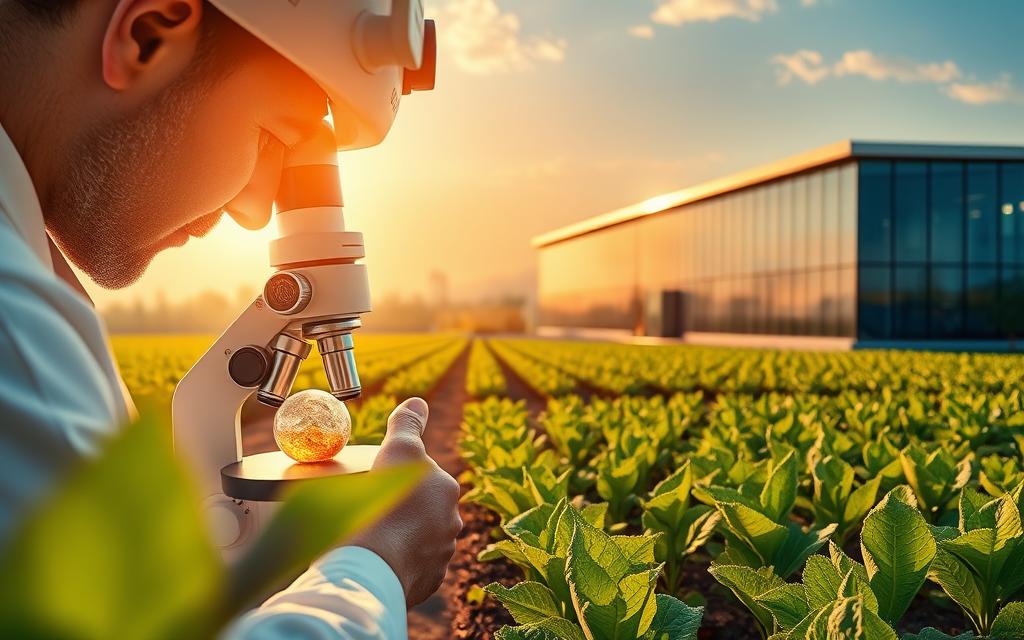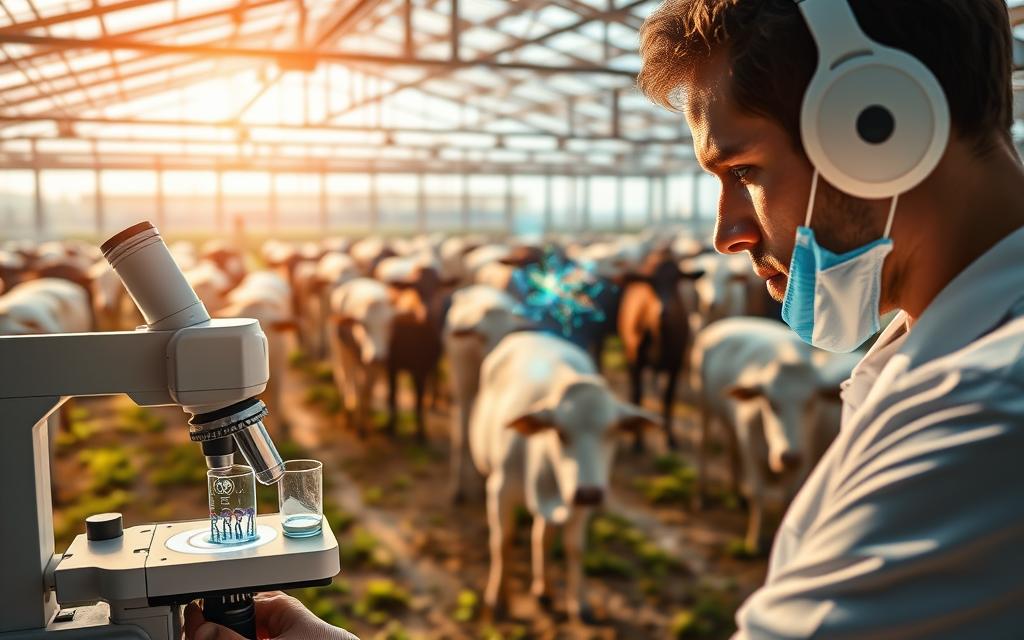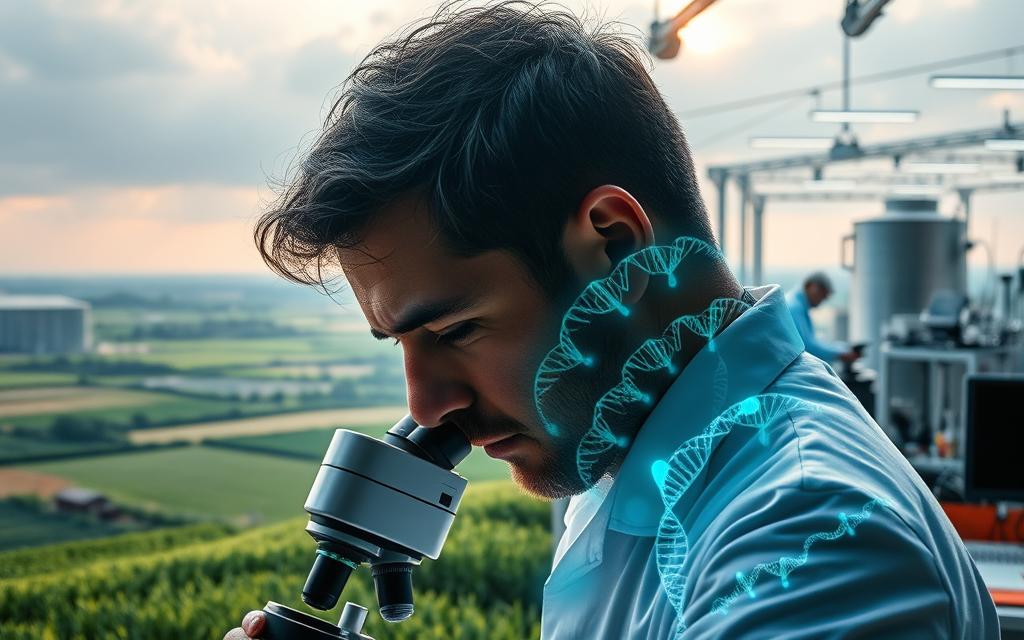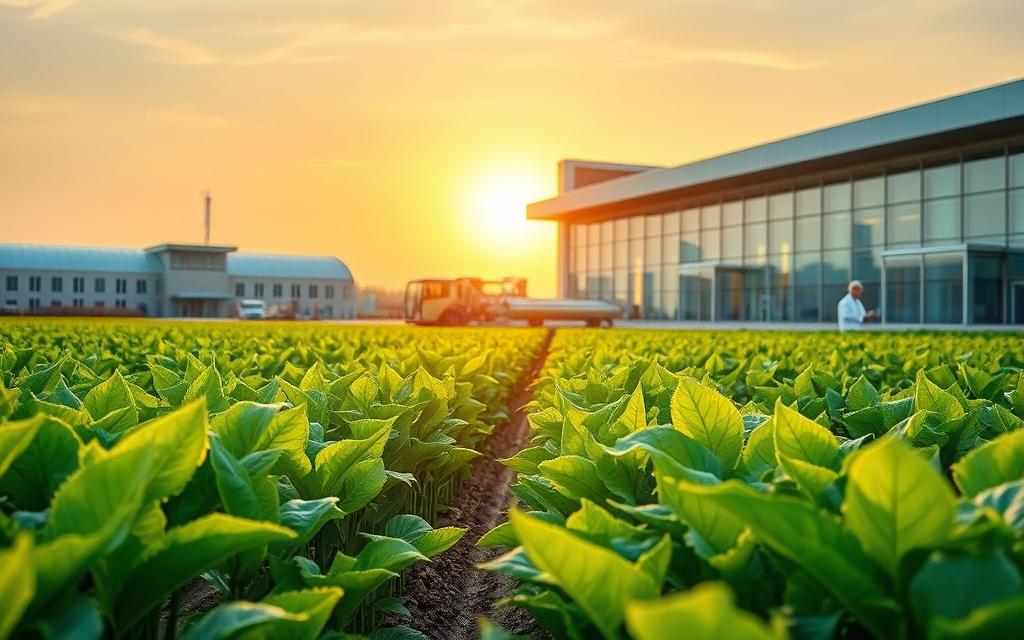The world of farming has changed a lot in the last 30 years. Agricultural biotechnology has become a key player, changing old ways of farming with new genetic tools.
Today, scientists make crops better by adding traits like resistance to insects and tolerance to herbicides. These changes help farmers protect their crops better and harm the environment less.
There are clear examples of how this technology works. In Hawaii, Rainbow papaya saved the papaya industry from a deadly virus. In Bangladesh, GMO eggplant cut down pesticide use and increased crop yields.
These achievements are just the start of what genetic engineering can do. It’s helping make farming more sustainable and productive all over the world.
The Foundation of Agricultural DNA Technology
Agriculture has always been about changing genes, but the ways we do it have changed a lot. Early farmers used selective breeding for thousands of years. Now, genetic engineering in farming is much more precise and powerful.
Understanding Genetic Modification Principles
Genetic modification is about changing an organism’s DNA to get certain traits. This is different from traditional selective breeding, which uses natural genetic changes.
Today, scientists can:
- Bring in genes from different species
- Target specific genes with precision
- Minimise unwanted changes
- Speed up the development of new traits
From early selective breeding to today’s advanced methods, our understanding of genetics has changed farming a lot.
Key Techniques in Agricultural Biotechnology
Several new technologies are key to modern agricultural biotechnology. They help scientists study, change, and improve genes with great accuracy.
PCR and DNA Sequencing Applications
Polymerase Chain Reaction (PCR) changed genetic analysis by making it easier to copy DNA segments. It has many uses in farming:
- Finding pathogens in crops and soil
- Finding genetic markers for good traits
- Checking if crops are genetically modified
- Seeing how genes work in different places
DNA sequencing works with PCR to give detailed genetic plans. Together, they are the base for advanced genetic engineering in farming.
Gene Editing Tools: CRISPR and Beyond
CRISPR-Cas9 is at the forefront of genetic modification tools. It works like molecular scissors, making precise changes in DNA.
CRISPR’s benefits include:
- High precision in genetic changes
- Faster development of new crops
- Potential for making improvements without transgenes
- Use in many different farm animals
Newer editing tools are coming, making things even more precise and useful. These tools are changing what’s possible in improving farm genetics.
The move from simple selective breeding to advanced gene editing is a big step in agriculture. These basic techniques are shaping genetic engineering in farming and helping solve global food issues.
How Does DNA Technology Contribute to the Agricultural Industry Through GMOs
Genetic modification is changing farming. It lets scientists add traits to plants that boost their growth and health. This new way of farming is helping farmers all over the world.

Enhanced Crop Protection and Pest Resistance
GMOs help fight pests in a natural way. They use genes from Bacillus thuringiensis to kill certain insects. This method keeps good bugs safe and targets pests only.
In India, Bt cotton has been a big success. Farmers saw increased yields and cut down on pesticides by half. This saves money and protects the environment.
Herbicide-resistant crops are another big help. They let farmers use weed killers without harming their crops. This leads to better soil health and less erosion.
Improved Nutritional Profiles and Food Quality
DNA tech can make food healthier. Scientists have made crops with more vitamins and minerals. This helps people get the nutrients they need.
Golden Rice is a big step forward. It has beta-carotene, which turns into vitamin A in our bodies. This could stop vitamin A deficiency and prevent blindness.
Food quality has also improved. Non-browning apples and potatoes last longer, reducing waste. Soybeans with healthier oils are better for our health.
“Genetic modification allows us to address nutritional deficiencies and reduce food waste in ways traditional breeding never could”
Increased Yield and Drought Tolerance
Drought-tolerant crops are vital in changing weather. They keep growing even when it’s dry. This helps farmers and keeps food on the table.
In Africa, drought-tolerant maize has seen yield increases of 20-35% in dry times. This helps small farmers grow food even when it’s hard.
Yield improvements aren’t just about drought. New crops grow better because they photosynthesise more efficiently. They also take up nutrients better and handle stress better. These changes help feed more people and reduce harm to the environment.
DNA technology in farming is a smart way to improve crops. It tackles many problems at once, from pests to nutrition and climate change. As this tech gets better, it will help make food production more sustainable for everyone.
Beyond GMOs: Advanced DNA Applications in Farming
Genetically modified organisms have changed farming a lot. But DNA technology is taking it even further. It’s moving farming into a new era with sustainable agriculture technology.
Precision Agriculture Through Genetic Markers
Genetic markers are key for precise farming. They help breeders find good traits quickly. This means crops can be improved more accurately.
Now, farmers can pick plants with the right genes for better growth or to fight off diseases. This makes farming faster and more efficient.
This technology is a big part of sustainable agriculture technology. It helps use resources better and boosts farm output.
DNA Barcoding for Species Identification
DNA barcoding is a game-changer for identifying species in farming. It uses short DNA sequences to tell species apart very well.
It’s used in labs to check seed quality and spot any mix-ups. It also helps in saving biodiversity in farms.
It’s also great for pest control. Knowing exactly what pests are there helps target treatments. This cuts down on harmful chemicals, making farming greener.
Microbial DNA Analysis for Soil Health
Looking at soil’s microbial DNA is a big leap in farming science. It lets farmers see how healthy their soil is in a new way.
This tech shows the tiny life in soil that’s key for plants and nutrients. It helps farmers manage soil better.
With this info, farmers can use fertilisers more wisely. This reduces harm to the environment and boosts crop health.
So, using microbial DNA analysis is a big step towards better sustainable agriculture technology. It makes farming work with nature, not against it.
DNA Technology in Livestock and Animal Agriculture
DNA technology has changed animal farming a lot. Precision farming genetics helps improve animal health and quality. It uses advanced genetic tools that were not possible before.

Genetic Selection and Breeding Programmes
Today, DNA analysis helps pick the best animals for breeding. Genomic selection lets farmers choose the right animals early. This speeds up improving animal traits.
This new method has changed how animals are bred. Farmers use genetic markers for better traits. These include:
- Improved feed conversion efficiency
- Enhanced meat quality characteristics
- Superior milk production capabilities
- Optimal reproductive performance
Research shows DNA technology helps breed cattle better. It benefits the earth and the beef industry by making breeding more efficient.
Disease Resistance in Animal Populations
Genetic engineering is a big help in making animals more resistant to diseases. Scientists can find and change genes for better immunity. This makes animals naturally fight off common diseases.
Transgenic methods have shown great results. A 1994 study by Devlin et al. showed how salmon could grow faster and fight diseases better with genetic changes.
“Genetic technologies represent our most powerful tool for developing sustainable disease management strategies in animal agriculture.”
This technology cuts down on antibiotic use. It also makes animals healthier and more productive.
Traceability and Food Safety Applications
DNA-based traceability has changed food safety in animal farming. It lets us track food from farm to table. This ensures quality and safety.
Traceability includes:
| Application | Benefit | Implementation Level |
|---|---|---|
| DNA fingerprinting | Product authentication | Widespread in premium markets |
| Pathogen detection | Early contamination identification | Growing adoption |
| Breed verification | Quality assurance | Industry standard for certified products |
| Origin tracing | Supply chain transparency | Increasing regulatory requirement |
These technologies protect consumers and help farmers keep their brands safe. They also meet strict food safety rules.
The use of precision farming genetics in animal farming is getting better. It offers new ways to farm sustainably and solve global food security issues.
Environmental Benefits and Sustainability Impacts
DNA technology is changing farming in big ways. It’s not just about growing more food. It’s about making farming better for the planet.
Reduced Pesticide and Herbicide Usage
Genetically modified crops are changing how we use chemicals in farming. They can fight pests without broad-spectrum insecticides.
This method cuts down on chemicals in waterways. It also protects good bugs and soil life. Farmers use up to 40% fewer pesticides now.
Herbicide-tolerant crops let farmers target weeds better. They use less herbicide and at lower doses. This means less pollution in soil and water.
Conservation of Biodiversity Through Technology
DNA tech helps save biodiversity in surprising ways. It lets farmers grow more food on the same land. This means less land is turned into farms.
Genetic markers help protect crop wild relatives. These relatives have genes that could improve crops in the future. Now, we can focus on saving the most important ones.
New breeding methods create crops that fit better with nature. Some crops need less land to grow. They can live alongside native plants and animals.
Climate Resilience in Agricultural Systems
Climate change is a big challenge for farming. DNA tech offers solutions with climate-resilient crops. These crops handle extreme weather better.
Drought-tolerant crops need less water to grow. This is key in areas with unpredictable rain. Farmers can save water and keep yields up.
Flood-resistant rice and heat-tolerant wheat are just a few examples. These crops help keep food production steady, even as the climate changes.
Soil health also gets a boost from DNA tech. Herbicide-tolerant crops mean less tilling. This helps keep carbon in the soil, fighting climate change.
The benefits of DNA technology for the environment are clear. It shows how farming can be kind to the planet, not just take from it.
Challenges and Considerations in Agricultural DNA Technology
Agricultural DNA technology has huge promise but faces big hurdles. These include regulatory and societal challenges. We must tackle these to use this tech responsibly and benefit our food systems worldwide.

Regulatory Frameworks and Safety Assessments
Worldwide, governments have strict rules to check GMO safety. These rules involve many agencies and long approval times.
In the US, the USDA, FDA, and EPA work together on GMOs. They look at environmental and food safety risks. This careful process aims to safeguard people and nature.
Issues like the Monarch butterfly study showed unexpected ecological harm. This led to more careful checks and detailed risk analyses. Now, regulators need lots of data before they say yes to new farm products.
Public Perception and Acceptance Issues
Many people are unsure about using DNA tech in farming. This doubt comes from misinformation and big controversies.
The Séralini study, which questioned GMO health risks, hurt trust in biotech. Even after scientists questioned it, the damage was done.
This doubt has led to bans in some places. Education and clear talks are key to understanding science and public views.
“The debate around agricultural biotechnology often reflects deeper concerns about food sovereignty and corporate influence.”
Intellectual Property and Access Considerations
Patents on DNA sequences and genetic tech raise big questions about ownership. Companies spend a lot on research, wanting to protect their work.
This system can block access for small farmers and poor countries. High costs and strict agreements might stop them from using needed tech.
There are efforts to make access fairer. Open-source biotech and partnerships between public and private sectors aim to help everyone. They want to keep innovation going while ensuring food for all.
Using DNA tech in farming must deal with these patent issues carefully. Finding a balance between protecting inventions and making sure everyone can use them is a big challenge for lawmakers.
Conclusion
DNA technology has changed farming, bringing new ways to grow food. It uses genetically modified organisms and advanced methods. These help crops grow better, taste better, and are kinder to the planet by using less pesticides.
CRISPR technology is the latest step forward. It allows for precise changes to plant genes, making them even better. But, there are hurdles like rules and doubts from the public.
Looking ahead, we need to keep improving crops to make them stronger and more resilient. CRISPR will play a big role in this. It’s all about making food systems better for everyone and the planet.
The future of farming looks bright with DNA technology. We just need to keep investing in research and use it wisely. This will help us feed the world and protect our environment for years to come.







